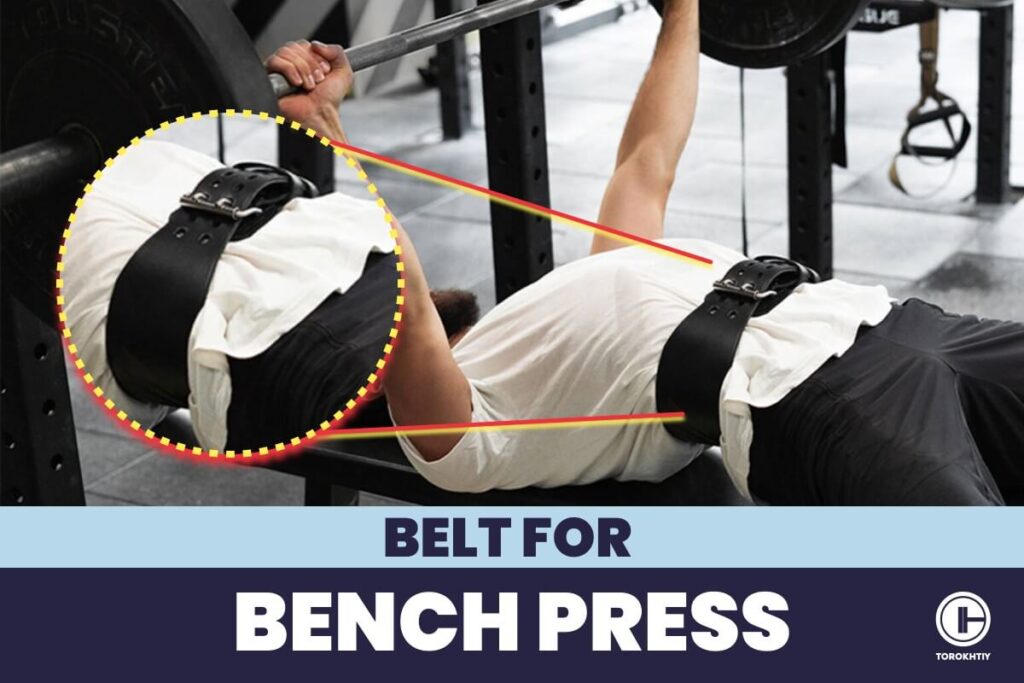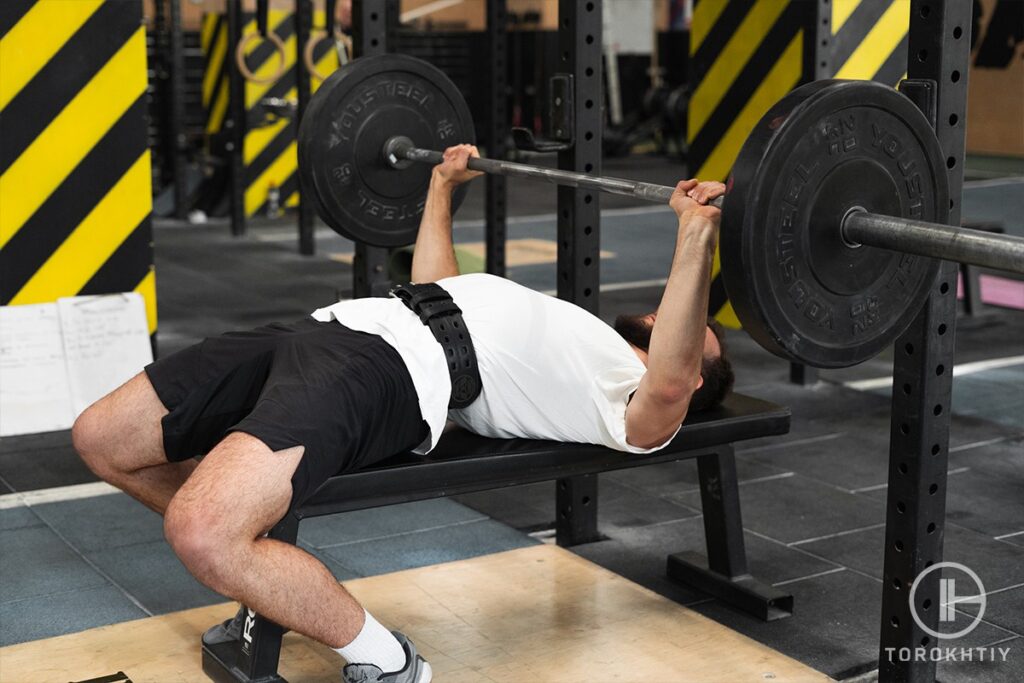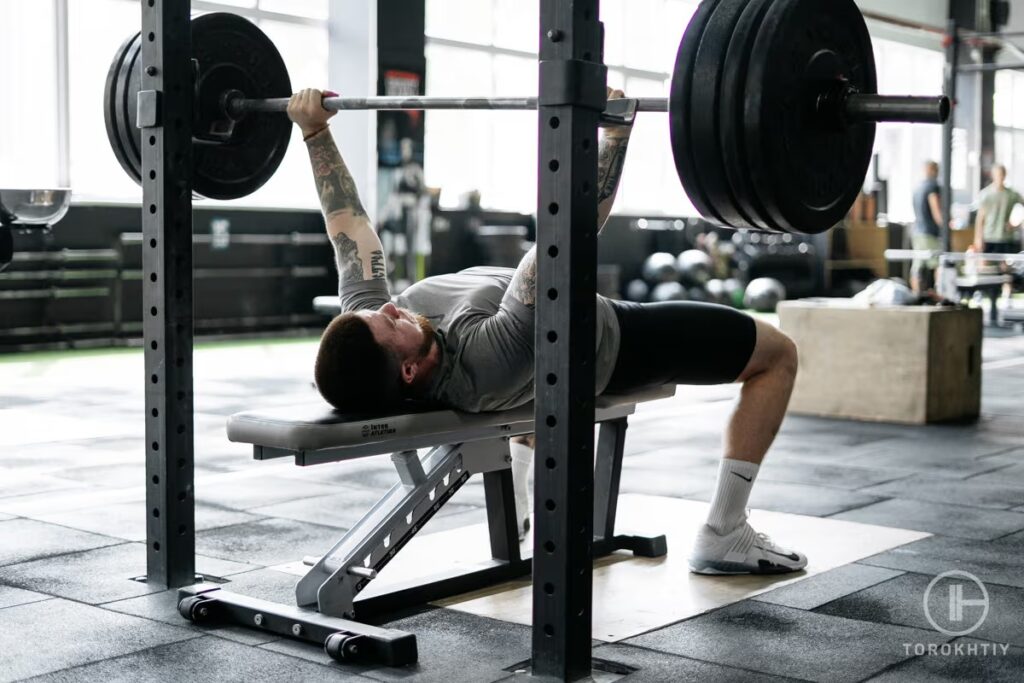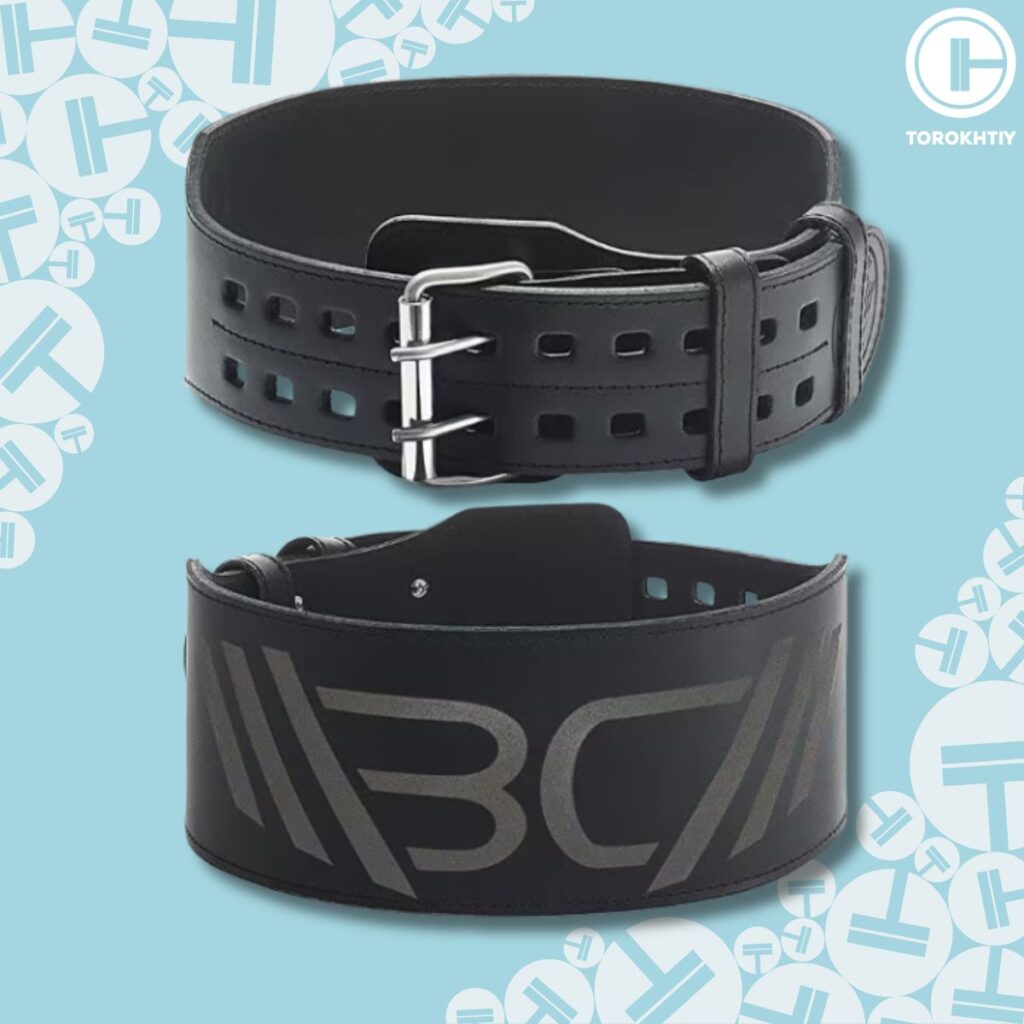Using Belt for Bench Press: 5 Pros & Cons
Author:
Reviewed by:
(Certified Nutritionist, S&C specialist, M.Sc.Eng. Biotechnology)
Unlock your full potential by engaging with our experts and community! Have questions about your fitness journey or looking for expert advice on weightlifting techniques? Don’t hesitate — leave a comment below and Oleksiy Torokhtiy will provide a personalized answer and insights to help you reach your goals.
Torokhtiy is reader-supported. Some links are affiliate links, and we may earn a commission at no extra cost to you. See our disclosure page for details.
Bench press is a complicated exercise that uses your entire body while pressing. Weightlifting belt can help the lifter, and give them a performance boost, but only if the belt is used properly. Otherwise, a belt may be counterproductive to your lifting goals.
When the belt is used properly, it can help the lifter engage their core, put their lower back in a safe arched position, and give them confidence in their lift. But if it isn’t, the belt can cause breathing problems and can become a mental crutch. So, it is important to learn how to wear a belt and practice lifting with it.

3 Benefits of Benching with a Belt
✅ Using Belt For Bench Press Can Help Engage The Core Muscles
You often hear the cue ‘engage your core’, but what does that mean? Many novice lifters believe that simply flexing their abdominal muscles engages their core, but that is incorrect.
In fact, what many people don’t understand is that your core wraps all the way around your torso and includes your abdominals, obliques, and even your lower back muscles.
So, when you hear ‘engage your core’ you don’t simply flex your abdominals, but you’re supposed to increase intra-abdominal pressure, push your obliques outward and in case of bench press possibly flexing your lower back a bit as well.
The triple movement fires up your entire core and creates a stable lower back. Once this is achieved, you can tackle heavier weights safely. Many people find it easier to engage their cores when they have an external source like a belt to push up against. This way, the belt acts as a reminder to improve your lifting form.
This is a big reason why using a belt when you bench press is important because your core and lower back are part of the big pressing movement. So, the belt can make the lift safer and can help with lower back pain as well when you bench press.
✅ Benching With a Belt Supports Your Bench Press Arch
Another misconception lifters might have when it comes to the bench press is that you should lay flat, with your back touching the bench, while pressing. When in reality, there should be a healthy arch in your lower back, with your glutes and shoulders resting on the bench.
The reason for this is by arching properly, you’re able to put your shoulders in a more comfortable, and safer position, while allowing your hips to settle underneath you, which can then help you get mechanical advantage when pressing heavier weights.
But in order to make sure your lower back stays healthy, you can bench with a belt on because it can help stabilize the lower back and lower the risk of injury. Also, the belt can allow you to get into a comfortable arched position as it supports your lower back. This will boost your bench press, while keeping you safe.
In reality, the bench press as a powerlifting exercise is a full body press where everything from the position of your feet to the firing of your glutes and hips plays a role in the press.
✅ Wearing a Belt While Benching Can Give You a Mental Edge
Your mentality plays a big factor in lifting heavy weights. Often, you have to first believe you can lift the weight before actually being able to do so. If you approach the weight thinking it will be too heavy for you, then you’ve already lost. This is what we call having confidence in your lift.
For some, wearing a weight lifting belt can give them the mental edge they require to handle heavy weights because they feel safe prior to the lift. The reason for this is that they might feel more confident knowing that there is something supporting their back, form, and core.
Also, the belt can act as a cue, where pressing against the belt helps you fire up your nervous system and focuses you on the task at hand.
It is the same idea as having a spotter when you’re attempting to lift heavy. Knowing that something or someone is there to keep you safe gives you a boost in confidence to push through plateaus and set new personal bests. So, in this way, see your belt as a tool for performance and use it when you need to in order to accomplish your lifting goals.

2 Reasons Why You Shouldn’t Use a Weight Lifting Belt for Bench Press
❌ Benching With a Belt Can Make It Difficult to Breathe
Before regularly wearing a belt for heavy lifts, you need to get used to it. If you aren’t used to using a belt while lifting, wearing one initially can interrupt your breathing pattern, which can then make you miss your lift. So, using a belt can become counterproductive.
A reason for this may be that you’re wearing the belt incorrectly, as people often tighten their weight lifting belts too much. This restricts the breathing pattern rather than engaging the core. If the belt is worn incorrectly, it can pinch the lower back, which is a sign that it is too low.
Or, the belt may compress ribs in the front, which is a sign that the belt is worn too high. Both of these mistakes affect your breathing and can cause you discomfort through the lift, making you fatigue quicker than usual.
Another reason may be that you’re performing higher repetition total. It can be difficult to keep a tight core while doing upwards of 10 reps or more, especially if you’re new to wearing a lifting belt.
One miss breath and your whole breathing pattern is thrown off course. So, it’s better to not use a belt on certain occasions or use it sparingly as you build your capacity to work with the belt on.
❌ Wearing a Weight Lifting Belt for Bench Press Can Make You Reliant on External Tools
As previously mentioned, a weight belt can act as a tool to help mentally overcome heavier weights, but, on the other hand, a belt can become a mental crutch too where you think you need it in order to lift.
Without it, you may think you’re unable to get into the proper position or engage your core, which then makes you dependent on something outside of your capabilities. When in reality, you should be bench pressing with the belt only occasionally, with weights close to your 1RM and even then not always.
People can overly rely on their belt and assume without it they are unable to lift heavy weights. This is why you have to be cautious of the tools you are using during your lifting sessions and understand the reason behind why you’re using them.
If you misuse the belt, wearing it when you don’t need to, and believe it’s the reason for your heavy lifts, then the belt can become a mental hurdle that you have to overcome in order to lift properly.
The belt is just a tool, don’t emphasize it as anything else.

Best Way of Wearing a Belt While Benching
You don’t want to simply throw the belt around your waist and crank it tightly to the point where it is difficult for you to even tighten your core or take a proper breath. Instead, put the weight belt around your waist in a comfortable position, somewhere near your belly button.
You want to tighten it, but not too tight because you need to be able to inflate your core into the belt. Generally, having enough space to squeeze a finger in between the belt and your core is a good indication that you have the belt on correctly.
Once the belt is on, push your core outward and feel your abdominal muscles, obliques, and lower back engage. When you get that feeling, then your belt is on right.
Some may have to adjust the belt according to their weight. The belt can be worn lower in order to push your belly up and out, allowing for a more comfortable lift. While for others, you may need to wear it slightly higher so it doesn’t pinch against their pelvis and lower back when they arch.
Having the right belt is also important for this process. We recommend using the Warm Body Cold Mind leather weight lifting belt to meet your lifting needs as it’s carefully designed by lifters for lifters.
Conclusion
When bench pressing, you want to engage your core and make sure your lower back is in a safe arched position and a belt can help with both things. It can also provide a mental edge to your lifting session. But, if worn incorrectly, it can be counterproductive, as it may interrupt your breathing pattern and force you to rely on it for heavy lifts.
Also read:
- Best Weightlifting Belt
- When to Use a Weight Belt
- What Size Lifting Belt Should I Get
- Nylon vs Leather Lifting Belt
- 10mm vs 13mm Belt
- Lever Belt vs Prong Belt
- Powerlifting Belt vs Weightlifting Belt
- Best Weight Lifting Belt for Women
- Deadlift Belt Position
- Best Weight Lifting Belt for Big Guys
- Best Deadlift Belt
References:
- Bench Press: The Arch: https://www.progressiverehabandstrength.com/articles/bench-press-arch.
- The Proper Form to Bench Press More Weight: https://www.bodybuilding.com/content/how-to-bench-press-layne-norton-complete-guide.html.
- Lessons in Weight Belts: How and Why to Use Them: https://www.bodybuilding.com/content/lessons-in-weight-belts-how-and-why-to-use-them.html.
- How to Use a Weightlifting Belt: https://www.youtube.com/watch?v=671OihFu9eg.
- How To Breathe & Brace When Lifting Heavy (SQUATS, DEADLIFTS, & OLYMPIC LIFTS): https://www.youtube.com/watch?v=TRmayQcweUc.
- All photos are made by Torokhtiy Media team.
Why Trust Us?
With over 20 years in Olympic weightlifting, strength training, nutrition coaching, and general fitness our team does its best to provide the audience with ultimate support and meet the needs and requirements of advanced athletes and professional lifters, as well as people who strive to open new opportunities and develop their physical capabilities with us.
By trusting the recommendations of our certified experts in coaching, nutrition, and sports training programming, as well as scientific consultants, and physiotherapists, we provide you with thorough, well-considered, and scientifically proven content. All the information given in the articles concerning workout programming, separate exercises, and athletic performance, in general, is based on verified data.
The product testing process is described in more detail here.
Author: Oleksiy Torokhtiy
Olympic Weightlifting Champion
Best Results: Snatch – 200 kg,
C&J – 240 kg
Oleksiy Torokhtiy is a professional athlete boasting 20 years of experience in Olympic weightlifting. With multiple European and World titles under his belt, he has showcased his prowess in two Olympic Games (Beijing 2008 and London 2012). Upon concluding his illustrious career, Oleksiy dedicated himself to coaching. By 2022, he had conducted over 200 weightlifting seminars worldwide. He is the visionary behind an international sportswear and accessories brand known for its motto, “Warm Body Cold Mind.” Additionally, he is an esteemed author and the creator of a series of training programs and eBooks.
Reviewed by: Jacek Szymanowski
Certified Nutritionist,
M.Sc.Eng. Biotechnology
Performance architect,
Strength and Conditioning Specialist
With over 30 years of fighting experience, specialization in nutrition coaching for athletes, and expertise in metabolic health and dietary strategies, Jacek offers a comprehensive approach to optimizing your performance and well-being. Backed by a Master of Science degree in Biotechnology, Jacek remains at the forefront of scientific advancements, ensuring that his coaching is always evidence-based and up-to-date.





Still have questions after reading our article? Unlock your full potential by engaging with our experts and community! Don’t hesitate — leave a comment below and Oleksiy Torokhtiy will provide a personalized answer and insights to help you reach your goals.